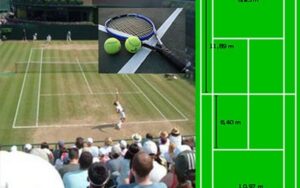SHARE WITH FRIENDS:
There are many people interested in tennis, and most of them are young people. Although parents want their children to be healthy through sports, they are afraid of getting injured. If you are a footballer, you can break your leg, and if you are a wrestler, you can injure any of your limbs. It is true that success in any field is impossible without hard work. Another thing is that a person who knows his profession well, who has learned it, and who is "stuck" in this way, does not eat pand.
According to experts, tennis is the physical sport in which athletes suffer the least injuries.
Today, tennis has become a very popular sport. That's why he has a lot of fans, tennis players.
Every athlete must know the history, development and rules of their field. Ordinary viewers - we won't lose if we let you know. Today we are learning about tennis.
Date of origin
The game of racket-tossing was played in ancient Greece, Rome, and elsewhere. During the Middle Ages and beyond, various "ancestors" of modern tennis emerged, developed, and changed in various parts of Europe. Examples are the British "field tennis", "court tennis", "long-pom", "wolf-pom" in France, Spain and Italy.
In the XNUMXth century, French aristocrats spent their leisure time playing "jyo de pom." This sport had a great influence on the development of modern tennis. In this favorite race of the nobility, leather balls covered with leather were played by hand, not with a racket. The ball does not jump well on the ground, so special halls were used for the stage. Over the years, these halls will host music and dance evenings. Such banquets are later called balls.
From the XNUMXth century onwards, it became customary to raise the ball with a racket. As the "game of the palm" changed, the British began to call it "real tennis".
The leather-covered balls used in those days were stuffed with sawdust, rags, and grass. Of course, such "snowballs" do not jump. The appearance of rubber balls did not require the use of paved areas, and now it was possible to play comfortably on the lawn. This event led to the rapid spread of the sport, which was widespread only in the Foggy Albion, to other regions.
The name tennis is derived from the imperative form of the French verb tenir. "Hold" means "hold". The athlete warned his opponent with this shout.
The term racket is also derived from the French word raquette. The phrase is actually derived from the Arabic word rakhat, which means "palm."
Formation
In 1874, Wingfield, an Englishman, developed a set of rules similar to modern tennis, which he called the "ball game." In fact, he did not make any new discoveries, but based his work on real tennis disciplines that were popular among aristocrats before the Great French Revolution. In 1875, the rules were significantly improved and renamed "lawn tennis" ("lawn" in English means "lawn", "meadow"). According to the International Tennis Federation, 1875 is the "birthday" of modern tennis.
Wingfield, who thought that the game could make a lot of money in the future, received a patent in 1874, which certified the inventor's copyright. But to no avail.
The official rules of the game were first adopted in 1875 by the Marylebone Cricket Club in London.
In 1869 he founded the All-British Croquet Club. Six years later, one of the team members, Henry Jones, offered the club tennis. The new game quickly became popular, and in 1877 the club was renamed the All-English Croquet and Lawn Tunis Club. Today, the club is known as the All-England Lawn Tennis and Croquet Club. However, his name Wimbledon is more popular.
In 1912, the International Laun-Tunisia Federation (ILTF) was founded. The federation was renamed the International Tennis Federation (ITF) in 1977. In 1963, the Women's Tennis Association (WTA) was formed.
First races
In 1877, the first lawn tennis tournament was held in Wimbledon, London. Only men took part in it.
In 1888, the Lawn Tennis Association was founded. The association has 43 rules for tennis. These rules still apply today.
The Wimbledon tournament is an unofficial world championship held annually on lawn courts. It is organized as the UK Open Championship. The prize pool averages £ 8,5 million. Due to the large prize pool, the British call it a "big fair".
In 1899, four students at Harvard University came up with the idea of holding a national team competition. One of them, Dwight Davis, arranges the tournament and buys a silver trophy for the winners at his own expense. The first tournament was held in 1900 in Brooklyn, Massachusetts, USA. It was attended by teams from the United States and the United Kingdom. The U.S. team, of which Davis is a member, unexpectedly won three matches. Since then, the competition has been held annually, with a few exceptions. In 1945, after the death of D. Davis, the tournament became known as the Davis Cup. This tournament is now considered one of the most important events in the world of tennis. In 2000, 132 countries participated in the Davis Cup.
Today, tennis is played by millions of people of all ages. According to the latest figures, the International Tennis Federation has about 190 national federations.
There are 4 major tournaments in the world of tennis:
-
Wimbledon tournament.
-
U.S. Open Championship.
-
Roland Garros Tournament (French Open).
-
Australian Open.
